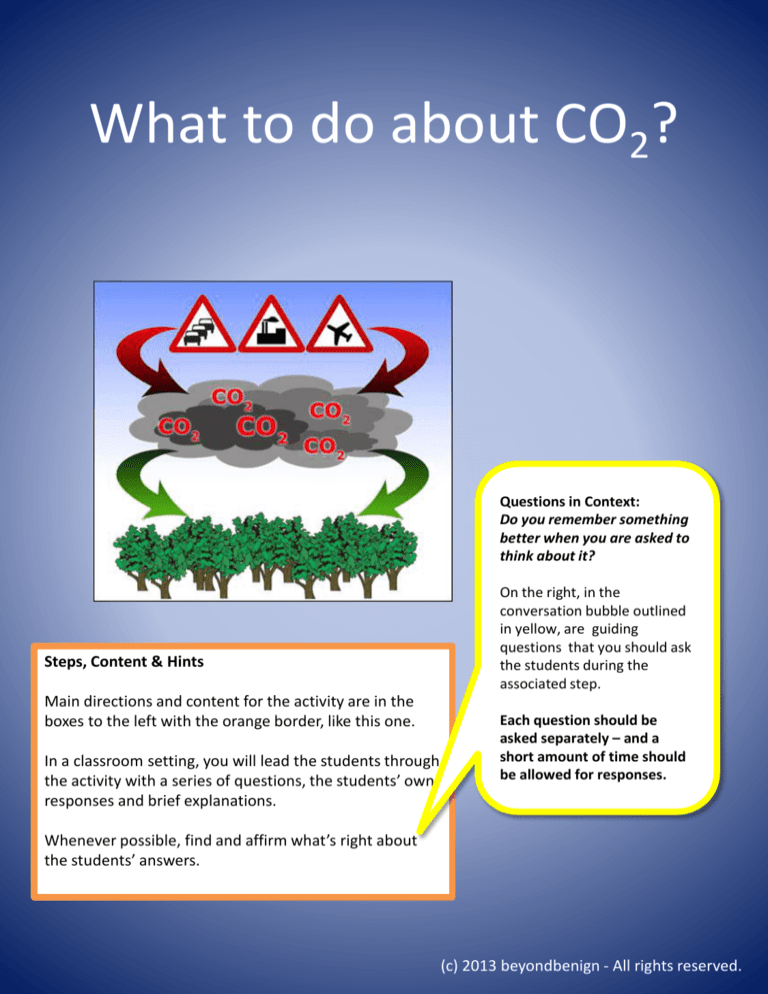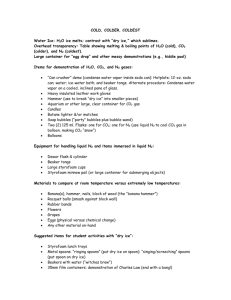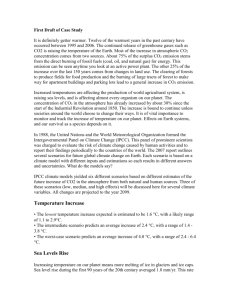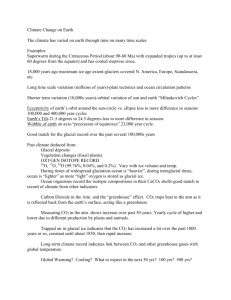
What to do about CO2?
Questions in Context:
Do you remember something
better when you are asked to
think about it?
Steps, Content & Hints
Main directions and content for the activity are in the
boxes to the left with the orange border, like this one.
In a classroom setting, you will lead the students through
the activity with a series of questions, the students’ own
responses and brief explanations.
On the right, in the
conversation bubble outlined
in yellow, are guiding
questions that you should ask
the students during the
associated step.
Each question should be
asked separately – and a
short amount of time should
be allowed for responses.
Whenever possible, find and affirm what’s right about
the students’ answers.
(c) 2013 beyondbenign - All rights reserved.
Green Chemistry Introduction:
Defining Green Chemistry
What is Chemistry? What does
chemistry mean to you? Do you
think of good things or bad
things? Who has heard of
companies going green? What
does that mean?
Have students work in pairs for 30 seconds to come up
with a definition for green chemistry. Break down the
meaning of both words.
Establish that Chemistry is the science of making
products.
Eco-friendly, good for the environment, sustainable.
What do Chemists do?
Use wait time . Build off of their prior knowledge.
Acknowledge student responses and prompt them for
more information. Control the conversation by asking for
a certain number of answers.
Is there anything in this room
that a chemist invented? What
about the desks, paint, floor,
etc.
Chemists are inventors. They help to design just about
every product out there.
Traditionally chemists were not taught about the
environmental impact or toxicology. We have had many
advances and helpful inventions but we have also had
inventions that have caused harm to the environment.
Green chemists design products taking into account the
entire process, energy efficiency, renewable resources,
the product itself along with the end-of-life impact of the
product.
Set the Scene:
Connect the Dots & Introduce the Activity Topic
Connect the dots for them: they are the future scientists
who will help to discover and invent the solutions to the
environmental challenges.
We will be learning about carbon dioxide today and the
effect on the environment.
Chemists make “stuff,” like
materials and medicines. Green
chemistry is pollution
prevention at the molecular
level, the basic design stage. So
what is it that green chemists
do?
Who has taken medicine? Does
anyone use an iPod or an mp3
player? What about a computer
or a cell phone?
Has anyone ever seen dry ice
before? What’s happening
here? Sublimation is when a
substance goes directly from a
solid to a gas.
Who knows what we/humans
breathe out? Carbon dioxide is
part of the natural world and
must be a good thing right?
Let’s do a few experiment and
find out more about carbon
dioxide.
(c) 2013 beyondbenign - All rights reserved.
Place 2 empty beakers in front of the class.
Place concrete slabs at the bottom of each beaker.
Crush one cube of dry ice and place in one beaker.
Seal the top with parafilm.
Seal the control beaker with parafilm as well.
Ask students to make predictions/hypothesis.
Come back to the beakers at the end of class and
observe the changes.
What do we think is going to
happen in this experiment?
We know that CO2 is
absorbed by plants will the
CO2 be absorbed by the
concrete? Why or why not?
Let’s come back to this at the
end of our session.
*** Come back to this experiment at the end of the
activities (or right after the ice cream is ready).
Discuss how there was a recent Presidential Green
Chemistry Challenge Award winning technology that is
making products using CO2. Also many researchers trying
to develop CO2 absorbent concrete.
Green chemistry technology considers 3 criteria:
Safety, Cost and Performance
Let’s understand a little bit about the problem and see if
we can use green chemistry technology to create a
solution.
(c) 2013 beyondbenign - All rights reserved.
What is the pH of distilled
water?
pH is a measure of acidity or basicity of a solution.
Whether a liquid is an acid or a base depends on the
types of ions in it. If it has a lot of hydrogen ions it’s an
acid. If it has a lot of hydroxide ions then it is a base.
It’s ok not to know the
answers this going to help
us to talk about the
differences between acids
and bases.
We are going to start by playing a game to talk about pH.
Each group will get a table with the 1-14 scale. You will
see a few of the common products are in place whether
they are acidic (1) or basic (14).
Has anyone ever spilled
orange juice on a cut
before? Did it sting? Does
OJ have more hydrogen
ions or hydroxide ions?
We are going to break the class into groups of 4 students.
Each group will receive a set of images to match on the
pH scale table. Do your best to fit the corresponding
images with the pH numbers.
Each group will share out one of their matched images
and pH estimate.
Take a look at the pH of sea water. Today we are working
with CO2 . Ocean acidification is a problem related to
excess CO2 in the environment. When one part of the
ocean is more acidic that means all of the ocean is more
acidic. Locally and globally ocean ecosystems are
affected that means both coral reefs in Australia and
lobsters in Boston!
Acids and bases neutralize
each other. Did you know
that our stomachs use
hydrochloric acid to help
digest food? Good thing we
have a protective liner.
Do we know anything
about CO2 problems or
challenges?
CO2 is a greenhouse gas
contributing to global
climate change it is also
causing ocean. Where is
this excess CO2 coming
from?
The burning of fossil fuels
produces excess CO2. Why
do we need to burn fossil
fuels? Energy etc.
(c) 2013 beyondbenign - All rights reserved.
Take a look at the pH of sea water. Today we are
working with CO2. Ocean acidification is a
problem related to excess CO2 in the
environment. When one part of the ocean is
more acidic that means all of the ocean is more
acidic. Locally and globally ocean ecosystems are
affected that means both coral reefs in Australia
and lobsters in Boston!
Procedure:
Measure 50 mL of salt water solution using
graduated cylinder
Pour salt water into 150 ml beaker
Test the pH of the sea water with pH strip
Add 5 drops of indicator
Using a protective glove, place 2 pieces of dry ice in a
wash bottle with some warm water. (When you close the
wash bottle you should have a steady stream of CO2
coming from the spout.)
Insert the wash bottle spout into the container with the
salt water solution
Observe and report what happens
Add base & repeat if time permits
Ocean acidification is
one of the problems
connected to excess CO2
. We are going to do an
experiment today that
simulates those
conditions.
What is the pH of the sea
water? What do you expect
will happen when we spray
CO2 gas into the sea water?
What did happen? Is
CO2 an acid or a base?
How can we limit the
amount of excess CO2
in our environment?
What if our concrete
acted as a CO2 sink?
(c) 2013 beyondbenign - All rights reserved.
Let’s use CO2 to make ice cream!
Hand out the materials. Each student gets 2 bags, ½ cup
of whole milk, 1 tbsp of sugar and ½ tsp of vanilla
What do we need to make
ice cream?
Has anyone every made it
before?
Demonstrate putting one bag into the other.
Once students have baggies they add:
½ cup of whole milk
1 tbsp of sugar
½ tsp of vanilla
(Depending on the time and size of the group you may
want to pre-measure ingredients) Other wise you can
prepare bowls of the supplies for each table and allow
students to measure themselves.
Once ingredients have been mixed together remove as
much air as possible and seal the Ziplock bags tightly. For
added security tape the outside bag closed.
Create a dry ice bath using salt, water and dry ice
(REMINDER: Dry ice is much colder than traditional ice
at -109.3°F or -78.5°C don’t let students handle with
bare hands)
Each dry ice bath will have 2-3 L of water and ½ a
container of salt and 500g of dry ice
If the mixture is not slushy enough adjust by adding more
water, dry ice and/or salt
Instruct the students to agitate their mixture in the bags
while submerged in the dry ice mixture
green chemistry
technology has 3 criteria:
cost, safety & performance
Let’s test the performance
of our ice cream.
After we eat our ice cream
let’s re-cap
Making the ice cream will take anywhere from 10-15
minutes depending on the dry ice slurry.
(c) 2013 beyondbenign - All rights reserved.
Let’s look back at the beakers from the start of this
activity.
Presidential Green Chemistry Challenge Award Winner
2012 Academic Award Professor Geoffrey W. Coates,
Cornell University
Carbon dioxide and carbon monoxide are ideal
feedstocks for chemicals but until now there had been
no efficient way to make them into valuable polymers.
Professor Coates created a family of catalysts that
convert CO2 and CO into polymers. Novomer is the
company that is using the technology to make a wide
range of products.
What happened to the
beakers? Did we see a
change?
What if we could capture
CO2 and convert it into
useful materials?
There have been several companies over the past few
years who have made headlines for researching and
developing concrete that absorbs moreCO2 than it takes
to make it. Currently 5% of all CO2 greenhouse gases can
be traced back to the manufacturing of concrete.
CO2 sinks and capturing CO2 is a big area of research. You
could be the one to help solve the problem!
(c) 2013 beyondbenign - All rights reserved.
Reiterate the 3 criteria of safety, cost and performance.
Great Job! Scientists ask questions and seek out answers.
Reinforce how green chemistry is the science of
solutions!
Who here asks questions
about how products are
made or why we have
certain problems?
Sounds like we have some
green chemists in the
room. Who thought that
this was easy? Who had
fun doing this? Do you
think that science is
something that you can
do?
In Closing:
Green chemistry provides the tools needed for creating
solutions to environmental challenges.
As a green chemist you can be a part of the solution by
inventing better technologies for the future. Also
remember that you do not need to be a scientist to make
a difference in this world. As an informed citizen you
have the power to influence change with your decision
making, voting power and purchasing choices.
Any questions?
Wrapping up is always a
good time to talk a little
more about why you are in
the classroom, what you
are studying, researching
or pursuing as a career.
(c) 2013 beyondbenign - All rights reserved.










